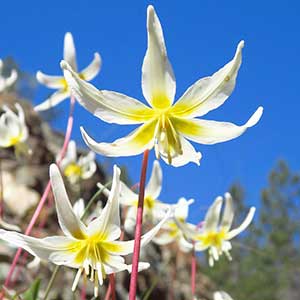Erythronium citrinum
Erythronium umbilicatum
citrus fawn lily, cream fawn lily, lemon color fawn lily, lemon fawn lily, pale fawn-lily
dimpled trout-lily
slender, 40–50 mm, sometimes producing sessile offsets.
ovoid, 10–25 mm;
stolons absent, or 1 per bulb on 1-leaved plants.
9–15 cm;
blade mottled with irregular streaks of brown or white, lanceolate to narrowly ovate, margins ± wavy.
5–17 cm;
blade green, irregularly mottled, elliptic to ovate-lanceolate, ± flat, not glaucous, margins entire.
12–35 cm.
4–18 cm.
1–3-flowered.
1-flowered.
tepals ± white, often pinkish, usually pale yellow at base, lanceolate to narrowly elliptic, 25–45 mm, inner with or without small auricles at base;
stamens 11–17 mm;
filaments linear, white or pinkish, slender, less than 0.8 mm wide;
anthers white, cream, pink, reddish, or brownish red;
style straight, white or pink, 6–10 mm;
stigma unlobed or with lobes shorter than 1 mm.
tepals strongly reflexed at anthesis, yellow, sometimes with brownish adaxial spots, variously tinged brown-purple abaxially, lanceolate, 13–30 mm, auricles absent;
stamens 9–18 mm;
filaments yellow, lanceolate;
anthers brown, purple, or infrequently yellow;
pollen brown, purple, or infrequently yellow;
ovary apex indented;
style deciduous or forming small apiculum, ± terete, not yellow, 8–24 mm;
stigma lobes spreading, 1.2–1.7 mm.
obovoid, 2–5 cm.
± resting on ground due to reclining peduncle, obovoid, 10–22 mm, apex indented, umbilicate, or rarely rounded.
= 24.
= 24.
Erythronium citrinum
Erythronium umbilicatum
Plants lacking auricles on inner tepals are sometimes segregated as Erythronium howellii, Howell’s fawn-lily, but they do not appear to differ from typical E. citrinum in any other characters. Erythronium citrinum intergrades with E. californicum and E. hendersonii, occasional populations or individuals displaying intermediate or recombined characteristics. Such plants from the upper Scott River drainage in Trinity County, California, which may be the result of introgression with E. hendersonii, have been recognized as variety roderickii.
(Discussion copyrighted by Flora of North America; reprinted with permission.)
Varieties 2 (2 in the flora).
(Discussion copyrighted by Flora of North America; reprinted with permission.)
1. Stolons absent; West Virginia to Alabama, Georgia, and n Florida. | subsp. umbilicatum |
1. Stolons present, 1 per bulb; North Carolina, Tennessee. | subsp. monostolum |
